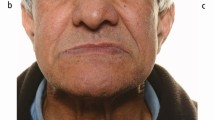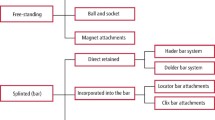Key Points
-
Allows readers to appreciate the level of facilitation of implant provision within primary care.
-
Highlights the need for informed consent when treatment planning for the edentulous patient.
-
Promotes the implant-supported overdenture as an effective treatment option for the edentulous patient.
-
Emphasises the need for further qualitative research into the decision-making process.
Abstract
Objective To investigate primary care practitioner participation in implant-supported mandibular overdenture (ISOD) provision. Design Postal questionnaire. Setting Primary dental care, North East England 2007. Subjects and methods Two hundred and ninety-five practitioners in North East England were sent questionnaires presenting a case-based scenario of a patient unable to manage a lower denture on an atrophic ridge. The questionnaire led them through the facilitation stages of ISOD provision, asking them to state their anticipated level of participation at each stage. Demographic details were also collected. Results Two hundred and seventeen responses were received (74%). Most practitioners would consider the option of provision of ISODs (89%) in this case and all who considered would discuss the option with the patient. Of those offering to facilitate treatment, 66% (122/184) would never deliver themselves, with the majority (60%, 111/184) referring within primary care. Statistical analysis showed associations between demographics and behaviour. Conclusions The majority of practitioners in this study area would facilitate ISOD provision in this case. Practitioners who are male and working in a practice where a framework for the provision of implants already exists are most likely to facilitate provision and/or provide an ISOD within primary care.
Similar content being viewed by others
Log in or create a free account to read this content
Gain free access to this article, as well as selected content from this journal and more on nature.com
or
References
Feine J S, Carlsson G E, Awad M A et al. The McGill consensus statement on overdentures. J Prosthet Dent 2002; 88: 123–124.
Thomason J M, Heydecke G, Feine J S, Ellis J S . How do patients perceive the benefit of reconstructive dentistry with regard to oral health related quality of life and patient satisfaction? Clin Oral Implants Res 2007; 18: 168–188.
Awad M, Lund J, Dufresne E, Feine J S . Comparing the efficacy of mandibular implant-retained overdentures and conventional dentures among middle-aged edentulous patients: satisfaction and functional assessment. Int J Prosthodont 2003; 16: 117–122.
Heydecke G, Penrod J R, Takanashi Y, Lund J P, Feine J S, Thomason J M . Cost-effectiveness of mandibular two-implant overdentures and conventional dentures in the edentulous elderly. J Dent Res 2005; 84: 794–799.
Raghoebar G M, Meijer H J, van't Hof M, Stegenga B, Vissink A . A randomised prospective clinical trial on the effectiveness of three treatment modalities for patients with lower denture problems. A 10 year follow up study on patient satisfaction. Int J Oral Maxillofac Surg 2003; 32: 498–503.
Ellis J S, Thomason J M, Jepson N J, Nohl F, Smith D G, Allen PF . A randomized-controlled trial of food choices made by edentulous adults. Clin Oral Implants Res 2008; 19: 356–361.
Esfandiari S, Lund J P, Thomason J M . General dentists can provide successful implant overdentures with minimal training. J Dent 2006; 34: 796–801.
Faculty of Dental Surgery of the Royal College of Surgeons of England. National clinical guidelines 1997. London: Royal College of Surgeons of England, 1997.
Butterworth C J, Baxter A M, Shaw M J, Bradnock G . The provision of dental implants in the National Health Service Hospital Dental Services - a national questionnaire. Br Dent J 2001; 190: 93–96.
el-Mowafy O M, Lewis D W . Restorative decision making by Ontario dentists. J Can Dent Assoc 1994; 60: 313–316.
Kronstrom M, Palmqvist S, Eriksson T, Soderfeldt B, Carlsson G E . Practice profile differences among Swedish dentists. A questionnaire study with special reference to prosthodontics. Acta Odontol Scand 1997; 55: 265–269.
Kronstrom M, Palmqvist S, Soderfeldt B, Carlsson G E . Dentist-related factors influencing the amount of prosthodontic treatment provided. Community Dent Oral Epidemiol 2000; 28: 185–194.
Exley C, Rousseau N, Steele J et al. Paying for treatments? Influences on negotiating clinical need and decision-making for dental implant treatment. BMC Health Serv Res 2009; 9: 7.
Buck D, Newton J T . The privatisation of NHS dentistry? A national snapshot of general dental practitioners. Br Dent J 2001; 190: 115–118.
General Dental Council. Principles of patient consent. London: GDC, 2006.
Dent A W, Paltridge D, Weiland J . Australasian emergency physicians: a learning and educational needs analysis. Part six: differences in confidence, exposure to learning and expressed learning needs by subgroups of Australasian emergency physicians. Emerg Med Australas 2008; 20: 347–356.
Ayers K M S, Thomson W M, Rich A M, Newton J T . Gender differences in dentists' working practices and job satisfaction. J Dent 2008; 36: 343–350.
Ipsos MORI. 1997–2007: ten years of measuring technology use. London: Ipsos MORI, 2007.
Fairbrother K J, Nohl F S A . Restorative dentistry: perceptions of general dental practitioners of a local secondary care service in restorative dentistry. Br Dent J 2000; 188: 99–102.
Newton J T, Thorogood N, Gibbons D E . The work patterns of male and female dental practitioners in the United Kingdom. Int Dent J 2000; 50: 61–68.
Edwards P, Roberts I, Clarke M . How to increase response rates to postal questionnaires. Evid Based Dent 2007; 8: 5–6.
Puffer S, Porthouse J, Birks Y, Morton V, Torgerson D . Increasing response rates to postal questionnaires: a randomised trial of variations in design. J Health Serv Res 2004; 9: 213–217.
Author information
Authors and Affiliations
Corresponding author
Additional information
Refereed paper
Rights and permissions
About this article
Cite this article
Field, J., Rousseau, N., Thomason, J. et al. Facilitation of implant provision in primary care. Br Dent J 207, E20 (2009). https://doi.org/10.1038/sj.bdj.2009.1013
Accepted:
Published:
Issue date:
DOI: https://doi.org/10.1038/sj.bdj.2009.1013
This article is cited by
-
Are UK graduates equipped with the skill set required to meet the demands of the UK's edentulous population?
British Dental Journal (2018)
-
Survey of consultants in restorative dentistry in the UK regarding ongoing care of patients provided with dental implants
British Dental Journal (2017)
-
The influence of specialty training, experience, discussion and reflection on decision making in modern restorative treatment planning
British Dental Journal (2011)



